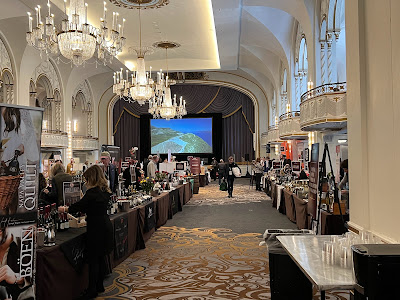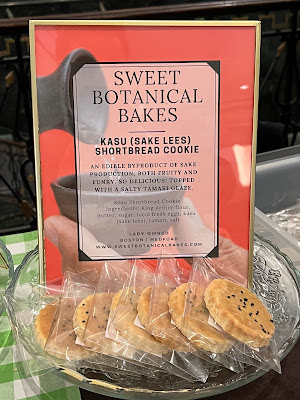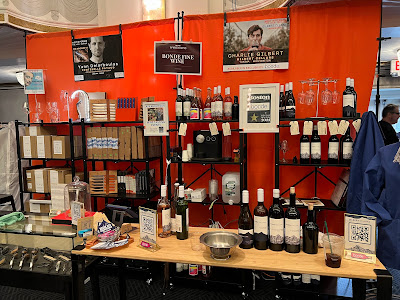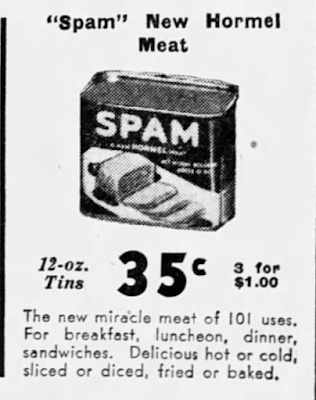Jay, who fought in World War I, had already proven himself in the company, when in 1921, he uncovered that one of their employees had embezzled over a million dollars from the company. He took control of Hormel just as the Great Depression struck. The above photo of Jay is from the Owensboro Messenger (KY), October 29, 1937.
Back in 1926, Hormel introduced Hormel Flavor-Sealed Ham, allegedly the first canned ham in the U.S., and maybe even the world. They would also introduce a canned chicken product in 1928. In the midst of the Depression, when the company's profits were decreasing, Jay took the bold step to introduce another new product, Spam, in 1937.
Allegedly, Spam was introduced on July 5, 1937, although that doesn't appear to be fully accurate. The Indianapolis Star (IN), May 25, 1937, noted that George A. Hormel & Co. had registered a trademark for the term “Spam.”
The first advertisement for Spam (pictured above) appears to have been in the
Star Tribune (MN), June 25, 1937, in an ad for the Piggly Wiggly grocery store.
It was described as "
Hormel Spiced Luncheon Meat, Cooked Ready to Serve" and sold for 29 cents for a 12 ounce tin. This is ten days earlier than the alleged date of its introduction, which might have simply been the "official" introduction, although it was available prior to July 5. Similar ads for Spam at the Piggly Wiggly were also printed in the
St. Cloud Times (MN), July 1, 1937, and
The Winona Republican-Herald (MN), July 2, 1937.
The
Minneapolis Star (MN), July 16, 1937, printed an ad for Broadway Theisen’s Market offering “Spam, Hormel’s Canned Lunch Meat” for 29 cents a can. The
St. Cloud Times (MN), July 22, 1937, had another Piggly Wiggly ad for Spam, but for 28 cents, one cent cheaper than the other stores. And in the
Minneapolis Star (MN), July 22, 1937, there was another Piggly Wiggly ad, noting, “
Spam. Hormel’s new Miracle Meat." However, it now cost 31 cents. This is also the first time that Spam is referred to as "Miracle Meat." The price was even higher in an ad in
The Minneapolis Star (MN), July 23, 1937, where Sanitary Meat Co. sold Spam for 35 cents.
Maybe the first full page advertisement for Spam was in the
Star Tribune (MN), July 23, 1937. The ad begins “Hormel Announces. New Miracle Meat helps you solve the summer food problem. This delicious new meat treat saves time when you need it most.” It also stated, “
Tender and juicy…SPAM is like no other meat you know. Slice it cold as it comes from the can…for luncheons, picnic sandwiches, salads, bridge parties, between meal snacks. Or serve it hot for breakfast as “SPAM and eggs”…or for dinner as “Baked SPAM”. Any way you eat it, SPAM hits the spot!” It also mentioned, “
Unlike most meats, you don’t have to crowd SPAM into your refrigerator. Just keep a supply on your pantry shelf.”
One of the most prominent selling points for Spam was that it didn't require refrigeration, and could be kept in your pantry for however long you wanted.
It also appears that Spam was being marketed to more affluent homes as well, as most people didn't have a maid to cook dinner for them.
Long before the iconic Spam skit by
Monty Python, Spam & Eggs was being touted as a special breakfast treat.
Baked Spam was another suggested dish, essentially sliced Spam topped by a dressing and baked in the oven.
Spam for lunch, a versatile food which can be served in a variety of ways.
The
Star Tribune (MN), July 26, 1937, offered the above advertisement, recommending Spam for picnics. As Spam didn't need refrigeration, it would be a good choice for packing for your picnic.
During June and July 1937, Spam was primarily sold in Minnesota, but advertisements in other states began in August, and by the end of 1937, Spam was available all across the country. The
Marshfield News-Herald (WI), August 12, 1937, might have printed the first Spam ad outside of Minnesota. It was in a grocery store ad, mentioning "
Hormel’s Spam (Spiced Ham)" for 29 cents.
The
Minneapolis Star (MN), August 13, 1937, offered the above ad.
The
Pittsburgh Press (PA), August 26, 1937, ran a grocery ad, noting: “
New! Hormel Spam. Just like Hormel Spiced Ham—an all-pork product. 12-ounce. Dollar Day price. 3 cans $1.”
Spam reached New York! The
Standard-Star (NY), August 26, 1937, printed a store ad that stated, “
Hormel Spam. New Spiced Ham” and it sold for 33 cents.
The first reference to the creation of the name "Spam." The Pittsburgh Sun-Telegraph (PA), August 26, 1937, had an advertisement that mentioned, “
Hormel does it again—This time it’s a combination of the most popular of all canned meat items—spiced luncheon meat and spiced ham—their vice president in charge of names picked out this one. Spam.” They sold 3 12-oz Spam tins for $1.00. The origin of the name would be elaborated in greater detail in later newspapers.
The
Minneapolis Journal (MN), September 2, 1937, again went for the picnic theme, promoting "
Spamwiches." The term "Spam" was easy to use to create catchy, new words.
An ad in the
Belvidere Daily Republican (IL), September 8, 1937, touted that there were 102 ways serve Spam. That's an odd number, and probably was just created out of thin air to promote the idea that Spam is versatile in many ways.
Spam in Hawaii! Today, Spam is hugely popular in Hawaii and Spam was first available there way back in 1937. The
Honolulu Star-Bulletin (HI), September 16, 1937, printed a store ad selling Spam for 35 cents, the highest price of anywhere else in 1937. I'll also note there were Spam ads in other states during this period, including California, Arizona, Michigan, Texas, and Montana. Spam was taking the entire country by storm.
Spam reaches Boston! In the
Boston Globe, October 4, 1937, there was an ad (pictured above) from the famed Jordan Marsh. The Spam cost 35 cents, or 3 for $1, which was also the highest price for Spam, comparable to the price in Hawaii. Interestingly, its noted that Spam had 101 uses, one less than a previous ad which touted 102 uses.
The
Courier-News (NJ), October 7, 1937, ran an ad that stated, “
Hormel’s Spam, A new sensational meat creation ready to serve.” It offered the 12 oz tin for 29 cents.
The
Los Angeles Times (CA), October 19, 1937, printed an ad with some additional details about Spam. It claimed that Spam is "
made of tender ham (center cut only), ever so slightly spiced.." The ad continued, noting that one tin could serves 4 persons.
And another full page ad for Spam in the
St. Cloud Times (MN), November 11, 1937.
The
Evansville Courier and Press (IN), August 7, 1938, provided some information about the success of Spam. The article began, “
Smack in the middle of the period last year when sales were generally on the decline, Hormel & Co. boldly brought forth an entirely new canned meat product, higher price and all, ran an employee contest to find a name for it, made a marketing test, then began to tell the country about Spam.” With the decline in sales, and a higher price than other products, putting Spam on the market was certainly a risky maneuver.
The article continued, “If observers wonder how Hormel managed to get Spam into nearly every grocery in the country where it ordinarily outsells similar products which retail for less, they may take a look at Hormel’s advertising program.” What was that advertising program? "One thing, besides consistency of appearance, which has distinguished its ads is consistency of new appeals. With a catch name to start off with, Hormel has used it to the hilt in promoting new tricky dishes in order to get the name across. Examples: Spam with scrambled eggs are Spambled eggs; Spam sandwiches, Spamwiches; Spam canapés, Spametts."
In Life Magazine, November 6, 1939, there was a lengthy article about Hormel and Spam. The article mentioned, “Pork shoulder meat with ham meat added,”—as shown on the label of the can is the secret of SPAM’s goodness and quality.” It was also mentioned, “Thus is pork shoulder meat, known as the juiciest and sweetest meat from any animal, prepared for the manufacture of SPAM.”
And the success of Hormel? The article noted, “Although Hormel is the fifth largest slaughterer of lambs and the sixth largest packer of beef in the U.S., it is pigs that have the center of Hormel attention. It is from pork that Hormel makes a delicious new kind of meat called SPAM.” It continued, “.., SPAM has become a favorite of millions of families from coast to coast.” It had become so popular that Hormel had to increase its production. “To meet their demands, Hormel has had to build additional SPAM manufacturing plants in Chicago, Indianapolis and St. Louis.”
There's a myth that during World War II, American GIs received huge portions of Spam, which they generally detested. They often stated that Spam was "ham that didn't pass its physical", or meatloaf "without basic training." You'll find plenty of websites still making these allegations, passing them off as "truth" although it wasn't the reality.
Even as far back as 1943, the reality was made known. The Minneapolis Star (MN), August 25, 1943, claimed that many World War 2 servicemen were actually thankful for Spam, however what they ate probably wasn't Spam. “Hormel has sold almost no Spam to the army and navy. What the soldiers and sailors get is an unnamed pork loaf, packed in six-pound oblong tins, that resembles Spam. The loaf is made according to government specifications by packers all over the country, including Hormel.” Spam was likely so popular that it had almost become a generic term for any type of canned pork loaf.
More info was also presented on the naming of Spam. The article stated, "The name Spam originated with an actor who was visiting the big packing plant here. A new pork loaf was being prepared and a contest was under way to select a name for it. Suggestions weren't so good. The actor dropped in with a relative who worked for Hormel. Told of the contest, he proposed Spam. Jay Hormel, president, knew at once that the loaf was named."
More information on the origins of Spam were provided in Life Magazine, March 11, 1946. First, it was mentioned that, “Jay Hormel inaugurated his Flavor-Sealed line of canned products in 1926 with a whole tinned ham. The next year he added spiced ham (the direct antecedent of Spam) and in 1928 canned chicken." As mentioned before, “With the depression, Hormel’s cherished Flavor-Sealed line began slipping badly, so he conceived the scheme of launching a brand-new product with a trick name..."
Jay started a series of contests, seeking a name for his new product, and it wasn't until a New Year’s Eve party at his own home that the name was finally chosen. At this party, "Each of the 65 guests was greeted at the door with a contest blank. The price of each drink was a completed entry in the contest. ‘Along about the third or fourth drink they began showing some imagination,’ Hormel recalls. Many of the names later adopted by competitors were offered and rejected. Finally the butler delivered to the host a slip of paper marked with the word SPAM.”
The magazine also discussed some of Spam's advertising history, stating, “In 1937 Spam went on public sale, ballyhooed by one of the earthiest, corniest and most successful promotion campaigns in U.S. advertising history.” One of the most unique aspects of this campaign was the creation of maybe the "first singing commercial." It was "a jingle set to the tine of Bring Back My Bonnie to Me."
"SPAM, SPAM, SPAM, SPAM
Hormel’s new miracle meat in the can,
Tastes fine, saves time,
If you want something grand ask for SPAM."
More information on the Spam naming contest. The Daily News (NY), October 10, 1954, discussed that Jay Hormel had offered $100 for a name for their new canned pork product. “A New York radio actor in town to visit his brother, a Hormel executive, wrote down Spam. The actor, Kenneth Daigneau, will be remembered more for that one word than for any lines he spoke on the air.”
Time Magazine, September 21, 1959, discussed the myth of Spam during World War II, helping to tell the truth. It was said, "The chewy, watery product that wartime G.I.s damned as Spam was really a lower-grade concoction, made under Army specifications: no ham (Spam itself has 6%-8%), cheaper cuts of pork, longer cooking of meat in the tin so that ersatz Spam could withstand tropical heat or Arctic cold."
The article also mentioned the success of Spam sales, which rose from 30 million cans in 1945 to 48 million in 1958. And in September 1959, they produced their one-billionth can!
************
What does the term "Spam" mean? Some think it might be a portmanteau word for either "spiced ham" or "shoulder of pork and ham." On the
FAQ on the Spam website, you'll find, "
What is the meaning of the SPAM® brand name?' Unfortunately, we can provide answers to neither. The significance of the SPAM® brand name has long been a subject of speculation. One popular belief says it’s derived from the words 'spiced ham.' The real answer is known by only a small circle of former Hormel Foods executives." So we may never know.
























































